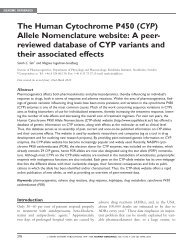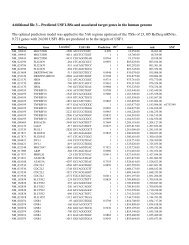Neurofibromatosis type 1-associated tumours ... - Human Genomics
Neurofibromatosis type 1-associated tumours ... - Human Genomics
Neurofibromatosis type 1-associated tumours ... - Human Genomics
Create successful ePaper yourself
Turn your PDF publications into a flip-book with our unique Google optimized e-Paper software.
REVIEW<br />
Laycock-van Spyk et al.<br />
allowing the cell to multiply uncontrollably and In<br />
even metastasize. This dramatic alteration in cellular<br />
control arises as a consequence of the accumulation<br />
of genetic and epigenetic changes: activated oncogenes<br />
speed up cell growth through the acquisition<br />
of gain-of-function mutations, whereas tumour<br />
suppressor genes (TSGs) promote progression by<br />
acquiring loss-of-function mutations. TSGs typically<br />
encode proteins involved in growth regulation,<br />
apoptosis initiation, cellular adhesion and DNA<br />
repair. In accordance with Knudson’s two-hit<br />
hypothesis, 6 both alleles of a TSG must be inactivated<br />
for cellular transformation to occur. Typically,<br />
a patient will inherit a germline mutation in one<br />
TSG allele; a second-hit or somatic mutation then<br />
occurs post-fertilisation, thereby inactivating the<br />
remaining wild-<strong>type</strong> allele. Somatic mutation is<br />
thus a key event in cancers <strong>associated</strong> with TSG<br />
inactivation. Upon transformation, a cell may<br />
acquire many additional somatic mutations elsewhere<br />
in the genome, a few of which actively<br />
encourage tumour progression, designated as<br />
‘driver mutations’, while most occur simply<br />
because of the increased number of cell replications<br />
and are usually of unknown biological consequence<br />
and so are designated as ‘passenger mutations’. 7<br />
The NF1 gene encodes neurofibromin, a negative<br />
regulator of the Ras/mitogen-activated protein<br />
kinase (MAPK) pathway. NF1 is a TSG and, consistent<br />
with Knudson’s two-hit hypothesis, most<br />
patients carry (in all their cells) both a normal and<br />
a dysfunctional NF1 gene copy — the latter harbouring<br />
the inherited (germline) mutation. It may<br />
be inferred that any <strong>tumours</strong> that arise will have<br />
acquired a second, somatic ’hit’ that inactivates the<br />
normal NF1 allele, resulting in a complete loss of<br />
functional neurofibromin; a double hit (NF1 2/– )<br />
is critical for NF1 tumorigenesis to occur. 8,9 The<br />
question as to why only a few of these benign<br />
<strong>tumours</strong> eventually go on to become malignant,<br />
however, is still puzzling. Consistent with a central<br />
role for neurofibromin in cellular function, recent<br />
cancer genome sequencing studies have found that<br />
somatic NF1 gene mutations occur not only in<br />
association with NF1, but also in a number of<br />
10 – 16<br />
other common cancers.<br />
the context of NF1, few geno<strong>type</strong>–pheno<strong>type</strong><br />
correlations are evident. Indeed, marked<br />
intrafamilial variation in terms of the clinical pheno<strong>type</strong><br />
is common. 5,17 The existence of such<br />
families is perhaps an indication of the importance<br />
of the second hit, since differences in the<br />
<strong>type</strong> and timing of somatic NF1 mutations may<br />
help to explain the variability in patient pheno<strong>type</strong>.<br />
18 An appreciation of the spectrum of<br />
somatic mutations in NF1-<strong>associated</strong> <strong>tumours</strong> is<br />
therefore essential if we are to understand the<br />
molecular pathways involved — itself a prerequisite<br />
for improvements in clinical treatment and<br />
the development of new therapeutics. This paper<br />
attempts to collate and review the spectrum of<br />
somatic NF1 mutations so far reported in<br />
NF1-<strong>associated</strong> <strong>tumours</strong>, with a view to assessing<br />
how they may serve to induce tumour growth<br />
and whether or not any geno<strong>type</strong>–pheno<strong>type</strong><br />
correlation may be discerned<br />
The NF1 gene: Structure and<br />
function<br />
The NF1 gene spans 283 kilobases (kb) of genomic<br />
DNA at 17q11.2 19 and contains 61 exons. 3,20<br />
Neurofibromin, the 327 kDa protein encoded by the<br />
NF1 gene, is translated from a 12 kb messenger<br />
mRNA transcript, and has a number of alternative isoforms<br />
21–24 (reviewed by Upadhyaya 25 ). Neurofibromin<br />
contains 2,818 amino acids and is expressed at low<br />
levels in all cells, with higher levels in the nervous<br />
system. It functions as a negative regulator of active<br />
Ras, and of the <strong>associated</strong> Ras/MAPK signalling<br />
pathway. Neurofibromin contains a Ras-specific<br />
GTPase activating protein (GAP)-related domain<br />
which interacts directly with Ras, resulting in a conformational<br />
change that greatly stimulates the intrinsic<br />
GTPase activity of the Ras protein, thus significantly<br />
accelerating the conversion of the active GTP-bound<br />
form of Ras into its inactive GDP-bound form and<br />
effecting a net decrease in overall mitogenic signalling<br />
in the cell. As the Ras/MAPK cascade is critical for<br />
the control of cellular growth and differentiation, a lack<br />
of functional neurofibromin results in the constitutive<br />
624 # HENRY STEWART PUBLICATIONS 1479–7364. HUMAN GENOMICS. VOL 5. NO 6. 623–690 OCTOBER 2011





